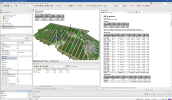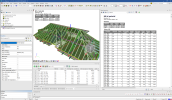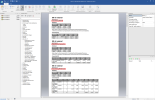Bill of material
The Bill of material command - available for PPEdefault since the release of SCIA Engineer 18.1 - enables you to get data about material quantities (volume, mass or surface) for 1D and 2D structural elements. Those results can be calculated for the entire model or just a selected part of the structure. Moreover, you can define for what materials specifically you want to get the BOM results and which type of predefined sorting with/without the price estimation you prefer to get optimal output according to your actual needs.
Usage of the command
To get a bill of material it's necessary to do the following steps:
1. Calculate a FEM analysis of the model
2. Go to Tree > Results > Bill of material to select the command
3. Adjust properties of the command in the Property Window:
a. Define selection of members (All / Current /...)
b. Select a type of sorting of the results from the following options:
Material - results are listed per each of used material class
Cross-section - results are listed per used cross-section (1D) and thickness (2D)
Member (1D) - results are listed per members (only for 1D) with specific cross-section and length
c. Decide whether you want to add the Price estimation to the bill or not
d. Specify materials you would like to consider in the bill
e. Input Unit prices of the considered materials (if price estimation is activated)
4. Click on [Refresh] action button to obtain the results
Provided results & output
A calculation of the BOM results (mainly mass, surface and volume) takes into account the real geometry of the members including haunches, arbitrary profiles or multi-material cross-sections in case of 1D members and variable thickness, composites and members with subregions and openings in case of 2D members. The presentation of results is provided in the standard way using Preview or Table Results application windows. The numerical output (in tabular form) is arranged according to the selected type of the filtering (per material, cross-section or member) for which the results are calculated for 1D and 2D members separately. The total values of the quantities are presented than for both types together in the "Summary" table which is presented at the beginning of the output.
Note: Please notice, that Surface value in the bill of material represents a different quantity for both type of members: for 1D it means total exposed surface while for 2D it corresponds to the surface area of the centroid plane.
Supported materials
| Material | Version of SciaEngineer | Description |
| Concrete | 18.1 | 1D and 2D |
| Reinforcement 1D | 20.0 | user reinforcement and reinforcement from PRAD |
| Steel | 18.1 | 1D and 2D |
| Aluminium | 18.1 | 1D and 2D |
| Timber | 18.1 | 1D and 2D |
| Masonry | 18.1 | 1D and 2D |
| Steel fibre concrete | 18.1 | 1D and 2D |
| Post-tensioned internal tendons | 20.0 | |
| Post-tensioned external tendons | 20.0 | Visible only in PPE v16 and older (not supported functionality in PPE default) |
| Pre-tensioned tendons | 20.0 | Visible only in PPE v16 and older (not supported functionality in PPE default) |
Assumptions and limitations
Existing limitations like considering openings for 1D members can be found in the E/W/N list below.
| Index | Type | Description |
| W-B/1 | Warning | Openings in members (1D) are not taken into account in the bill of material! |
| W-B/2 | Warning | Orthotropy defined on members (2D) is neglected in the bill of material, the original thickness value is used in the calculation of the bill of material! |
| N-B/1 | Note | Members (1D) with haunches are listed separately from the prismatic members of the same cross-section type. |
| N-B/2 | Note | For members (1D) with arbitrary profile, each partial cross-section is listed separately. |
| N-B/3 | Note | For members (1D) with multi-material cross-section, each cross-section part (material) is listed separately. |
| N-B/4 | Note | For members (2D) with variable thickness, the 'Thickness' stated in the table corresponds to the average thickness value (due to sorting of the table). |
| N-B/5 | Note | For members (2D) modelled as a composite deck, each material (sheeting and concrete deck) is listed separately. |
| N-B/6 | Note | Length of tendons is calculated as (theoretical length of 1 tendon + overhang on prestressed side + overhang on nonprestressed side) * (Number of tendon elements in tendon (ns) * Number of tendons in group (nq) * number of tendons with the same area) |
| N-B/7 | Note | Length of tendons is according 1D member on which tendons are allocated. |
Note: Please notice, that applied property modifiers (changing properties like self-weight or mass) are not considered in BOM results.






